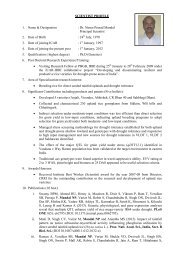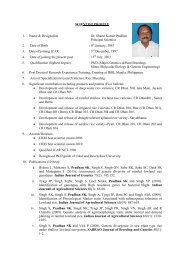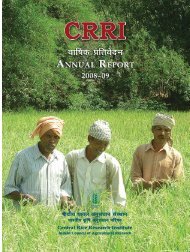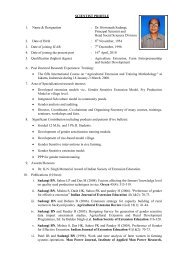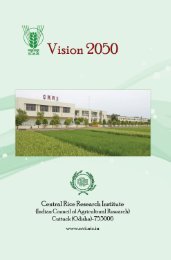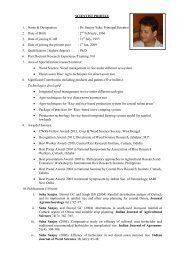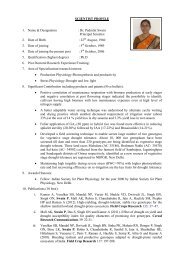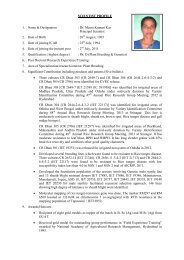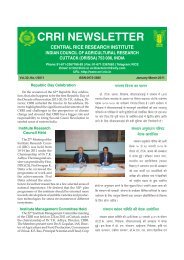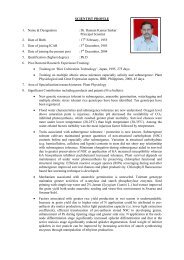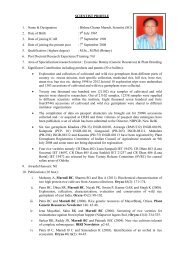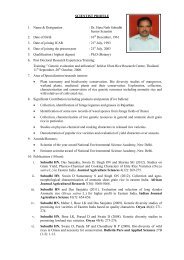Central Rice Research Institute Annual report...2011-12
Central Rice Research Institute Annual report...2011-12
Central Rice Research Institute Annual report...2011-12
Create successful ePaper yourself
Turn your PDF publications into a flip-book with our unique Google optimized e-Paper software.
Table 26. Rhizosphere P concentrations (mg kg -1 ) of the rice cultivars planted to the soils of different P status<br />
grown under flooded conditions<br />
NaHCO 3<br />
-P*<br />
NaOH-P*<br />
21 DAT Panicle Flowering 21 DAT Panicle Flowering<br />
<strong>Rice</strong> Cultivars initiation initiation<br />
Khuntuni soil (P-deficient)<br />
IR28 7.4 ab 5.7 c 5.3 b 25.5 b 19.0 b 17.0 b<br />
IR36 7.8 a 7.8 a 6.6 b 28.0 ab 23.0 a 20.6 a<br />
Dular 7.0 b 6.6 b 6.2 a 30.2 a 23.6 a 22.5 a<br />
Ranital soil (P-medium)<br />
IR28 13.9 a <strong>12</strong>.1 b <strong>12</strong>.3 a 30.6 b 28.6 a 24.5 a<br />
IR36 14.2 a 13.3 a 11.7 a 34.3 a 26.8 a 23.0 a<br />
Dular 13.8 a <strong>12</strong>.5 b 11.7 a 32.3 ab 23.8 b 22.8 a<br />
CRRI soil (P-sufficient)<br />
IR28 28.6 b 25.6 a 23.6 a 71.7 a 54.1 b 49.7 a<br />
IR36 30.0 a 25.5 a 23.6 a 66.2 b 57.0 a 50.3 a<br />
Dular 26.7 c 24.5 b 22.3 b 61.6 c 52.4 b 45.7 b<br />
CV (%) 2.6 4.8<br />
Comparison S.E.D. LSD (P=0.05) S.E.D. LSD (P=0.05)<br />
2-G×S×V 0.3 0.7 1.4 2.8<br />
* Mean of four replicate observations<br />
In a column under each soil type, mean followed by the common letter are not significantly different (P< 0.05) by<br />
Duncan’s Multiple Range Test (DMRT). DAT: Days after transplantation; G: Growth stage; S: Soil type; V: Variety<br />
cific regulation of biosynthesis and release of root exudates.<br />
Results showed that rice cultivars releasing tartaric,<br />
malic, citric and acetic acids could extract P from<br />
strongly absorbed soil P fraction, thereby increasing<br />
native soil P utilization efficiency. In all the three soil,<br />
Olsens P were more (ranged from 7.0 to 30.0 mg kg -1 ) at<br />
21 DAT when the acid secretion in the root exudates<br />
were maximum (Table 26).<br />
Nitrogen-Variety trials<br />
In order to find out the production potential of selected<br />
AVT-2 rice cultures and their response to varying<br />
levels of nitrogen viz., 50, 100 and 150 percent of<br />
recommended dose of N, two trials were conducted in<br />
different rice ecosystems during wet season 2011. In<br />
AVT-2 (Early) transplanted trial, two early cultures IET<br />
21401 and IET 21637 were tested against standard<br />
checks Sahbagidhan and Tulasi along with local check<br />
Vandana. The culture IET 21367 gave highest grain<br />
yield of 4.24 t ha -1 and was comparable to other tested<br />
cultures including checks. These tested cultures responded<br />
significantly up to 60 kg N ha -1 .<br />
In AVT-2 (ME) aerobic, the tested culture IET 21680<br />
produced significantly higher yield (4.52 t ha -1 ) over<br />
the checks Rasi (4.02 t ha -1 ) and IR-64 (3.34 t ha -1 ) and<br />
responded significantly up to 80 kg N ha -1 .<br />
Development of Production Technologies<br />
for Aerobic <strong>Rice</strong><br />
Development of agro-management practices<br />
for enhancing crop and water productivity in<br />
aerobic rice<br />
A field experiment was conducted with three irrigation<br />
water (IW) depths (25, 50 and 75 mm) in main plots<br />
and three IW/CPE ratios (0.8, 1.0 and 1.2) in subplots<br />
and replicated thrice to optimize the irrigation schedule<br />
in aerobic rice cv. Apo. Grain yield of aerobic rice<br />
reduced significantly with increase depth of irrigation<br />
from 25 to 75 mm but increased with increase in IW/<br />
CPE ratio from 0.8 to 1.2 (Fig. 19). However, irrigating<br />
the crop with higher IW depth and IW/CPE ratio recorded<br />
significantly higher grain yield over lower IW<br />
depths and IW/CPE ratio. Highest grain yield of 3.34 t<br />
ha -1 with irrigation water productivity of 0.61 kg grain<br />
m -3 of water was recorded when aerobic rice was irrigated<br />
with 25 mm of water at IW/CPE ratio of 1.2. The<br />
number of effective tillers decreased by 21.2% with increase<br />
in irrigation water depth from 25 to 75 mm but a<br />
62 CRRI ANNUAL REPORT 2011-<strong>12</strong>



